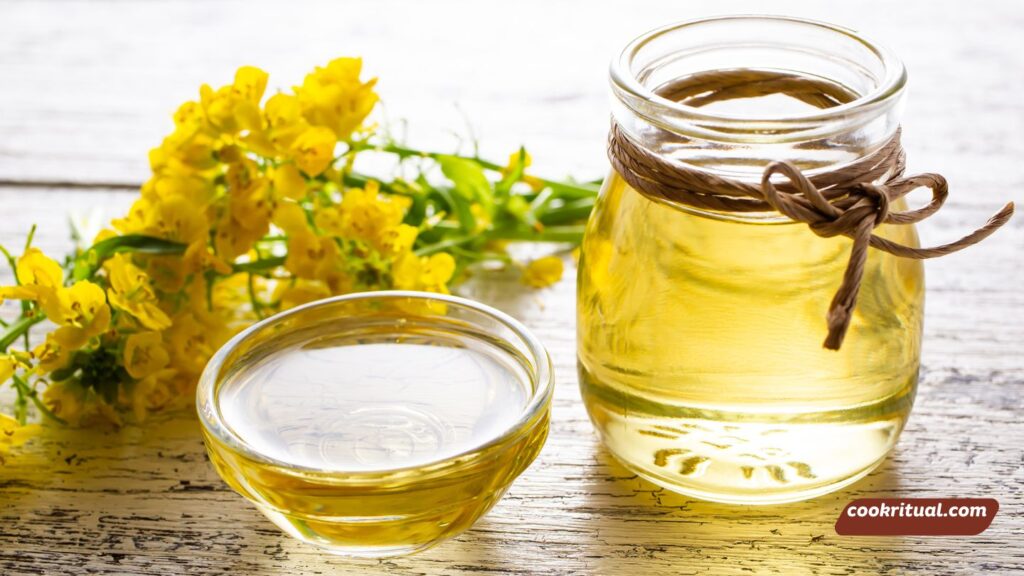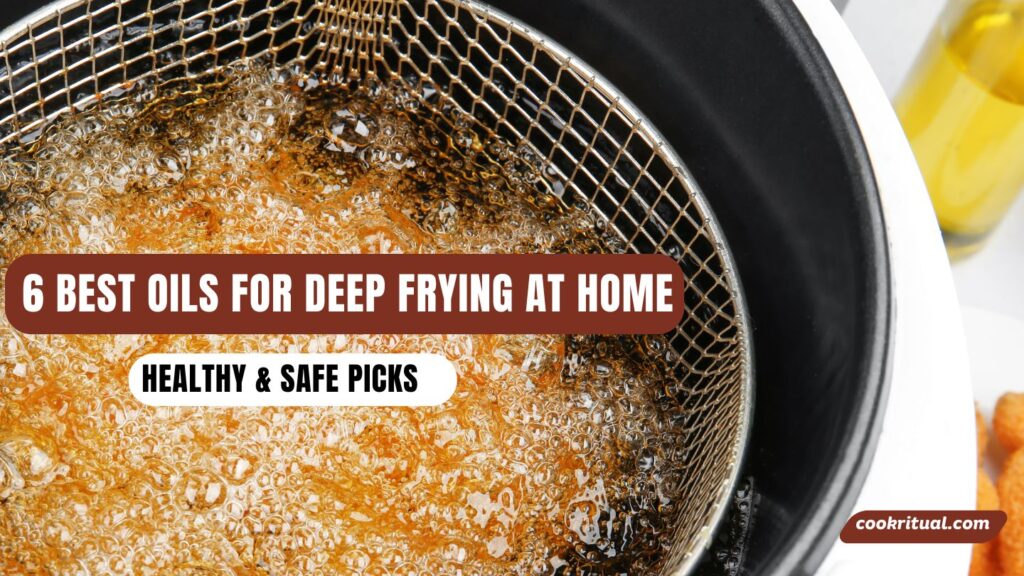The best oils for deep frying at home are those with high smoke points, neutral flavors, and a balance between performance and health benefits. Whether we’re frying crispy chicken, golden fries, or homemade donuts, the oil we choose can make or break the final result—not just in taste and texture, but also in how healthy and safe the meal turns out.
In home kitchens across the U.S., deep frying has become more than just an indulgence. With the right oil and technique, it’s possible to enjoy delicious fried foods while still making mindful choices about fats, flavor, and nutrition. But with so many options lining grocery store shelves—canola, peanut, vegetable, sunflower, avocado—how do we know which ones are actually best for deep frying?
In this guide, we’ll explore the top six oils that deliver consistent results, offer health-conscious advantages, and suit a range of budgets and cooking needs. We’ll also walk through essential tips for deep frying safely at home, compare key oil features, and answer common questions to help everyone—from beginners to seasoned home cooks—make the smartest choice for their kitchen.
Contents
- 1 What Makes a Great Deep Frying Oil?
- 2 The 6 Best Oils for Deep Frying at Home (Ranked & Reviewed)
- 3 Comparison Chart: Deep Frying Oils at a Glance
- 4 Best Practices for Deep Frying at Home
- 5 How to Store and Reuse Deep Frying Oils Safely
- 6 Related Products: Tools and Accessories for Home Deep Frying
- 7 Buying Guide: Choosing the Right Oil for Your Frying Needs
- 8 FAQs: Best Oils for Deep Frying at Home
- 9 Final Thoughts and Recommendations
What Makes a Great Deep Frying Oil?
Not all cooking oils can handle the heat of deep frying. To get that perfect golden crunch without burning or creating harmful compounds, we need oils that can take high temperatures without breaking down. That’s where something called the smoke point comes in.
What is Smoke Point and Why Does It Matter?
The smoke point is the temperature at which an oil starts to smoke and break down. When that happens, it releases free radicals and a substance called acrolein, which gives off a burnt smell and can affect both flavor and health.
Oils with high smoke points (typically above 400°F) are ideal for deep frying. They stay stable at high heat and keep food crispy, not greasy. Harvard Health points out that using the right oil can also help reduce the risk of heart disease when chosen carefully.
Other Things That Matter in a Deep Frying Oil
- Neutral Flavor: A light or neutral taste helps the food shine. We don’t want our donuts tasting like olive oil.
- Stability: Good frying oils hold up over time, especially if reused.
- Health Profile: We look for oils lower in saturated fats and higher in monounsaturated fats, which the American Heart Association supports for heart health.
- Availability and Cost: We also want something easy to find at the store and that doesn’t break the bank.
With that in mind, let’s look at the best oils that check all these boxes.
The 6 Best Oils for Deep Frying at Home (Ranked & Reviewed)

We tested and reviewed several popular oils based on smoke point, taste, health, and how well they work in a home kitchen. Here are the six that came out on top.
1. Peanut Oil
Peanut oil is a favorite for deep frying—and for good reason. It has a very high smoke point (about 450°F), a clean flavor, and gives food a nice crispy finish. It’s especially good for frying chicken or seafood.
Pros:
- High smoke point
- Reusable and stable
- Light, clean flavor
Cons:
- Not safe for those with peanut allergies
- Slightly higher in omega-6 fats
Source: USDA FoodData Central
2. Canola Oil
Canola oil is one of the healthiest and most affordable oils for deep frying. It has a mild flavor and a smoke point around 400°F. It’s also low in saturated fats and high in heart-healthy fats.
Pros:
- Budget-friendly
- High in monounsaturated fats
- Neutral flavor
Cons:
- Less stable if reused too many times
- Refined versions are better for frying
3. Vegetable Oil Blend
This is a go-to oil in many U.S. households. It’s a mix (often soybean, corn, or sunflower oils), offering a decent smoke point (around 400°F) and good performance at a low cost.
Pros:
- Easy to find
- Works well for all-purpose frying
- Inexpensive
Cons:
- Flavor can vary
- Not always labeled clearly
Source: Cleveland Clinic
4. Sunflower Oil
Sunflower oil is known for its light flavor and crisp results. With a smoke point around 440°F, it’s great for frying delicate foods like fish or fritters.
Pros:
- High smoke point
- Clean taste
- High in vitamin E
Cons:
- Can be pricey
- High in omega-6 fats
Source: Healthline
5. Avocado Oil
Avocado oil has the highest smoke point of any cooking oil—up to 520°F. It’s rich in healthy fats and has a slightly buttery flavor that can enhance some dishes.
Pros:
- Extremely high smoke point
- Full of healthy fats
- Great for pan and deep frying
Cons:
- More expensive
- May not suit all flavor profiles
Source: Medical News Today
6. Corn Oil
Corn oil is another reliable choice for deep frying. It has a neutral flavor, a smoke point around 450°F, and is often used in commercial kitchens.
Pros:
- Widely available
- Affordable
- Good heat stability
Cons:
- Often highly processed
- High in omega-6 fats
Source: WebMD
Comparison Chart: Deep Frying Oils at a Glance
Here’s a quick look at how the top six oils compare side by side.
| Oil | Smoke Point (°F) | Flavor | Best For | Reusability | Cost |
| Peanut Oil | 450 | Neutral | Chicken, seafood | High | Moderate |
| Canola Oil | 400 | Neutral | General frying | Medium | Low |
| Vegetable Oil | 400 | Mild/Varies | All-purpose | Medium | Low |
| Sunflower Oil | 440 | Light, clean | Fish, fritters | Medium | Moderate |
| Avocado Oil | 520 | Buttery, mild | Premium frying | High | High |
| Corn Oil | 450 | Neutral | Commercial use | High | Low |
This table helps us match the right oil to what we’re cooking, how much we’re willing to spend, and whether we want to reuse the oil safely.
Best Practices for Deep Frying at Home

Deep frying at home can be fun and tasty—when done safely and the right way. It’s not just about dropping food into hot oil. A few simple habits can make a big difference in flavor, texture, and health.
Preheat the Oil to the Right Temperature
The best range for deep frying is 350°F to 375°F. Too cool, and the food soaks up oil. Too hot, and it may burn or even smoke. Use a kitchen thermometer to keep the oil in the safe zone. The CDC recommends using a thermometer for food safety at home.
Don’t Overcrowd the Pot
Putting too much food in at once lowers the oil’s temperature. That can make food soggy instead of crispy. Fry in small batches for the best results.
Choose the Right Tools
Use long-handled tongs or a slotted spoon to move food around. Wear oven mitts or long sleeves to protect from hot oil splashes. A deep pot with high sides is safest.
Use a Lid—Just in Case
If oil splashes or catches fire, never use water. Cover the pot with a lid and turn off the heat. The National Fire Protection Association (NFPA) offers guidelines for cooking fire safety.
Drain Fried Foods Right
Let fried foods rest on a paper towel-lined plate or a wire rack. This helps drain extra oil and keeps the coating crispy, not greasy.
How to Store and Reuse Deep Frying Oils Safely
Good oils aren’t cheap. The good news? Many frying oils can be used more than once if stored the right way. Here’s how to make the most of them.
Let the Oil Cool First
Never try to handle or pour hot oil. Wait until it’s fully cooled—at least an hour after cooking. This keeps things safe and prevents burns.
Strain Out the Crumbs
Tiny food bits left in the oil will burn next time. Use a fine mesh strainer or cheesecloth to remove them. Clean oil means better flavor and fewer odors.
Store in a Cool, Dark Place
Pour the strained oil into a glass jar or bottle with a tight lid. Label it with the date and what food was cooked in it. Store it in a pantry or fridge.
Know When to Toss It
Used oil gets darker, thicker, and smells off when it’s time to throw it out. If the oil foams or smokes at a lower temperature than before, it’s done.
The FDA suggests always using clean containers and checking oil before reuse to avoid spoilage.
How Many Times Can Oil Be Reused?
It depends on what was cooked and the type of oil. Here’s a quick guide:
| Oil Type | Times You Can Reuse | Best For |
| Peanut Oil | 3–5 times | Chicken, fries, seafood |
| Canola Oil | 2–4 times | Veggies, doughnuts |
| Sunflower Oil | 2–3 times | Fish, fritters |
| Avocado Oil | 4–5 times | High-heat cooking |
| Vegetable Oil | 2–3 times | General frying |
Related Products: Tools and Accessories for Home Deep Frying
The right tools make deep frying at home easier, safer, and more fun. These kitchen essentials help get great results every time.
Deep Frying Thermometer
A clip-on thermometer helps keep oil at the perfect temperature. Look for one that goes up to at least 400°F. Digital ones are fast and easy to read. Consumer Reports lists top-rated food thermometers for home use.
Oil Storage Container with Strainer
These handy containers make it easy to filter, store, and reuse oil. Look for a metal canister with a mesh filter built in. It helps remove crumbs while keeping the oil clean.
Frying Basket or Slotted Spoon
A mesh basket helps lower and lift food without splashing. If using a pot, a slotted spoon works well for small batches.
Cast Iron or Heavy-Bottom Pot
Deep, heavy pots hold heat better and help maintain oil temperature. Cast iron Dutch ovens or stainless-steel pots are great options for safe frying.
Splatter Guard or Lid
Protect countertops and hands from hot oil splashes with a wire mesh splatter guard. It lets steam out but keeps oil in.
Buying Guide: Choosing the Right Oil for Your Frying Needs
Choosing the best oil depends on what you’re cooking, your health goals, and your budget. Here’s how to pick the right one for your kitchen.
1. Think About Temperature
If you fry often at high heat, you’ll want an oil with a high smoke point—above 400°F. For lower temps or quick fries, oils with moderate smoke points can still work. Learn more about smoke points from Cleveland Clinic.
2. Match the Flavor
Some oils have strong flavors, like coconut or avocado. Others are neutral, like canola and vegetable oils. Go for neutral oils when you don’t want the oil to change the taste of the food.
3. Check the Nutrition
Health-conscious cooks should look for oils that are low in saturated fat and high in monounsaturated fats. The American Heart Association recommends heart-healthy oils like canola, sunflower, and avocado.
4. Think About Cost
Premium oils like avocado cost more but may last longer with repeated use. If you’re frying often or in large amounts, budget-friendly oils like vegetable or peanut oil may be better.
5. Storage Space
Some oils need to be stored in a cool, dark place. If your kitchen gets hot, look for stable oils with longer shelf lives—like refined peanut or corn oil.
FAQs: Best Oils for Deep Frying at Home
Can I use olive oil for deep frying?
While extra virgin olive oil has many health benefits, it has a lower smoke point (around 375°F) and a strong flavor. Refined olive oil can be used for frying but may not be the best choice for high-heat deep frying. Learn more from Harvard Health.
Is it safe to reuse oil after deep frying?
Yes, most oils can be reused 2–5 times. Make sure to strain it, cool it fully, and store it in a sealed container. Throw it out when it smells bad, looks dark, or foams when reheated. See the FDA’s guide to cooking safety for best practices.
What oil do restaurants use for deep frying?
Many restaurants use peanut, soybean, or canola oil. These are stable, have high smoke points, and are budget-friendly for bulk frying.
What’s the healthiest oil for deep frying?
Avocado oil ranks high for its heart-healthy fats and ultra-high smoke point. Canola and sunflower oils are also good picks for light frying with health in mind.
What happens if I use the wrong oil?
If the oil has a low smoke point, it can burn quickly, taste bitter, and create harmful compounds. Always choose an oil that matches your cooking method.
Final Thoughts and Recommendations
Deep frying can be a healthy, safe, and delicious cooking method—if we use the right oil. The best oils for deep frying are the ones that balance high smoke points, neutral flavor, and good nutrition.
Peanut oil and canola oil are top picks for everyday home cooks. If health is your top goal, avocado oil is a great investment. And when you need something budget-friendly, vegetable or corn oil works well.
Always preheat the oil carefully, avoid overcrowding, and reuse oil the right way. That’s how we get golden, crispy food without the extra grease or waste.

